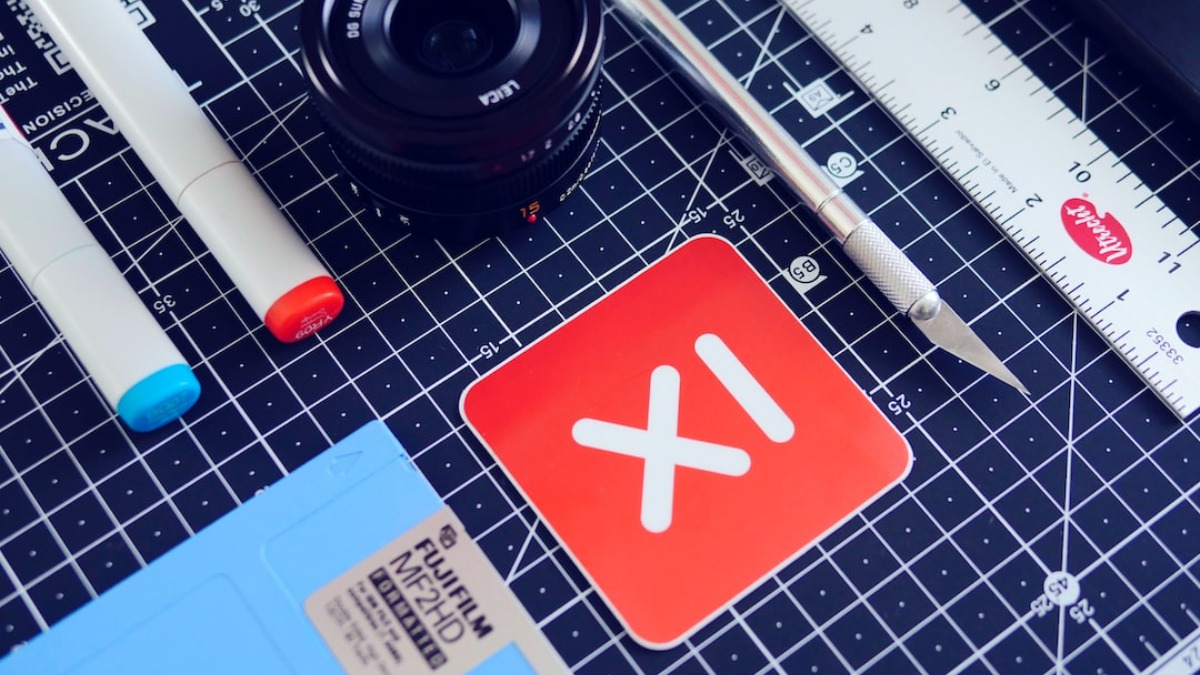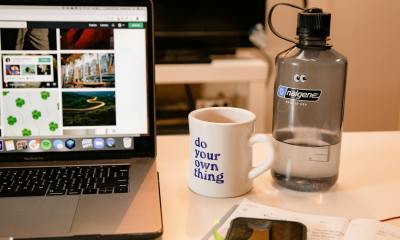AI
How to Create a Premium Logo for Your Blog Online

Introduction
In today’s digital age, blogging has become an increasingly popular means of sharing thoughts, expertise, and creative content with a global audience. Whether you’re a seasoned blogger or just starting your journey, one thing is clear: a well-designed logo is essential for establishing a strong brand identity. Your blog’s logo is the visual representation of your content, and it plays a crucial role in attracting and retaining readers.
Creating a premium logo for your blog may sound like a daunting task, especially if you lack design experience. However, with the right tools, techniques, and a dash of creativity, you can craft a logo that not only captures your blog’s essence but also leaves a lasting impression on your audience. In this comprehensive guide, we will walk you through the step-by-step process of creating a stunning logo for your blog online.
1. Understanding the Importance of a Blog Logo
The Role of a Logo in Blogging
A blog logo is more than just a pretty graphic. It’s a visual cornerstone of your brand, serving as a symbol of your blog’s identity and values. In a crowded digital landscape, a well-crafted logo helps your blog stand out and makes it instantly recognizable. It becomes a mark of trust, establishing a connection with your audience.
The Impact of a Well-Designed Logo
A premium blog logo can have several positive effects on your blogging journey:
- First Impressions: It’s often the first thing readers see when they visit your site, creating an immediate impression of your blog’s professionalism and credibility.
- Memorability: A unique and memorable logo can stay in your readers’ minds long after they’ve left your site, making them more likely to return.
- Branding: Your logo should reflect your blog’s niche and values, creating a cohesive brand identity that resonates with your target audience.
- Social Media Presence: An attractive logo is essential for social media profiles, helping you maintain a consistent and professional image across platforms.
- Monetization Opportunities: A strong brand, supported by a compelling logo, can open doors to monetization opportunities, such as sponsorships and merchandise sales.
Now that you understand why a blog logo is crucial, let’s dive into the steps to create one that’s premium and reflective of your brand.
2. Defining Your Blog’s Brand Identity
Identifying Your Niche and Audience
Before you start designing your logo, it’s essential to have a clear understanding of your blog’s niche and target audience. Your logo should resonate with the interests and preferences of your readers. If you blog about travel, your logo might incorporate elements like globes or suitcases. For a food blog, it could include culinary symbols or utensils. Know your niche, and you’re on your way to a logo that speaks directly to your audience.
Your Blog’s Unique Selling Proposition (USP)
What sets your blog apart from the thousands of others in your niche? This unique selling proposition (USP) should guide your logo design. If your blog offers a particular perspective, expertise, or experience, make sure your logo communicates that distinctiveness.
Mood and Aesthetics
Consider the mood and aesthetics you want your blog to convey. Is it fun and playful, serious and informative, or something in between? Your logo’s design, colours, and fonts should align with this mood. For example, a tech blog might opt for clean lines and modern fonts, while a lifestyle blog may choose more whimsical elements.
Once you’ve defined your brand identity, it’s time to gather inspiration.
3. Gathering Inspiration
Exploring Successful Blog Logos
Start your logo design journey by researching successful blog logos in your niche and beyond. Analyze what makes these logos effective and memorable. Note colour schemes, font choices, and the use of imagery. This research can provide valuable insights and spark ideas for your own logo.
Using Pinterest and Mood Boards
Pinterest is an excellent tool for creating mood boards filled with logo design inspiration. Collect images, colour palettes, and typography samples that resonate with your brand’s identity. Mood boards can help you visually organize your ideas and convey them to a designer or during the DIY design process.
Creative Brainstorming
Take time to brainstorm and sketch logo concepts. Start with rough sketches to explore various ideas, even if you’re not an artist. These initial sketches can help you refine your vision and serve as a basis for more polished designs later on. Be open to unconventional ideas, as sometimes the most unique concepts lead to the best logos.
In the next section, we’ll delve into the different logo types and how to choose the right one for your blog.
4. Choosing the Right Logo Type
Wordmark Logos
Wordmark logos are text-based and focus primarily on the blog’s name or initials. They are simple, clean, and easy to read. If your blog’s name is distinctive and memorable, a wordmark logo might be the perfect choice.
Lettermark Logos
Similar to wordmarks, lettermark logos use the initials of your blog’s name as the central element. This style is ideal if your blog’s name is long or difficult to pronounce. Lettermarks can be stylized to create a unique and recognizable mark.
Pictorial Logos
Pictorial logos incorporate a simple graphic or symbol that represents your blog’s theme or values. These icons should be memorable and easily associated with your blog. If you want a logo that can stand alone without the blog’s name, a pictorial logo may be the way to go.
Abstract Logos
Abstract logos are artistic representations that don’t necessarily resemble anything specific. They often use shapes, lines, and colours to convey a mood or concept. These logos are open to interpretation, making them versatile for various niches.
Combination Logos
Combination logos blend text and imagery to create a comprehensive representation of your brand. They can be more complex but offer the advantage of conveying both your blog’s name and its theme or values in a single design.
When choosing a logotype, consider your brand identity, niche, and audience preferences. Your logo should be a natural extension of your blog’s personality. Once you’ve decided on a logotype, it’s time to explore colours and fonts.
5. Selecting Colors and Fonts
The Psychology of Colors in Logo Design
Colours have a profound impact on human psychology and can evoke emotions and associations. Consider the following when choosing colours for your blog logo:
- Red: Excitement, passion, energy
- Blue: Trust, reliability, calm
- Green: Growth, nature, health
- Yellow: Happiness, optimism, warmth
- Purple: Creativity, luxury, elegance
- Black: Sophistication, power, elegance
- White: Simplicity, purity, cleanliness
Your color choices should align with your blog’s mood and message. Additionally, consider how your logo will look in both color and grayscale, as it will be used in various contexts.
Typography: Fonts and Styles
Typography plays a significant role in logo design. The font you choose should be legible, align with your brand’s personality, and complement the overall design. Some popular font styles for blog logos include:
- Serif Fonts: Elegant and traditional
- Sans-Serif Fonts: Clean and modern
- Script Fonts: Elegant and handcrafted
- Display Fonts: Unique and eye-catching
Ensure that your chosen font is available for commercial use and web embedding. Consistency in font usage across your blog and social media is also essential for branding.
Establishing a Color Palette
A well-defined colour palette ensures consistency in your blog’s branding. Choose a primary colour (usually one or two) and a secondary colour to accompany it. These colours should be harmonious and reinforce your blog’s mood and identity.
With your logotype, colours, and fonts decided, it’s time to move on to the actual design process.
6. Designing Your Logo
Online Logo Makers and Design Tools
You don’t need to be a professional designer to create a stunning blog logo. Numerous online logo makers and design tools are user-friendly and offer pre-designed templates. Some popular options include Canva, LogoMaker, and Looka (formerly Logojoy).
These tools provide a canvas for you to experiment with your chosen logotype, colours, and fonts. You can customize templates to fit your vision or create a logo from scratch. Remember to export your logo in a high-resolution format to ensure it looks crisp and professional.
Hiring a Professional Designer
If you have the budget and desire for a completely unique and professional logo, consider hiring a graphic designer. A professional can bring your vision to life and ensure your logo meets all design standards. Platforms like Fiverr and Upwork connect you with talented designers who can create a logo tailored to your brand.
DIY Logo Design Tips
If you choose to design your logo yourself, here are some DIY tips:
- Start Simple: Begin with basic shapes and elements, then gradually add complexity as needed.
- Balance and Proportion: Ensure that the elements in your logo are balanced and proportionate to create a visually pleasing design.
- Test on Different Backgrounds: Check how your logo looks on various backgrounds to ensure it remains legible and visually appealing.
- Keep It Scalable: Your logo should look great whether it’s displayed as a small favicon or on a large banner.
- Stay Consistent: Use your chosen color palette and fonts consistently throughout the design.
- Seek Feedback: Don’t hesitate to ask for feedback from friends, family, or online communities to refine your design.
Once your logo is designed, it’s time to add a catchy slogan or tagline.
7. Crafting a Memorable Slogan or Tagline
The Role of a Tagline
A slogan or tagline complements your logo by summarizing your blog’s mission or value proposition in a few words. It can add depth and context to your brand and make it more memorable. For example, Nike’s iconic tagline, “Just Do It,” encapsulates the brand’s philosophy and resonates with consumers.
Creating a Catchy Slogan
Crafting a compelling slogan or tagline can be challenging but rewarding. Keep these tips in mind:
- Be Concise: A great tagline is short and to the point, making it easy to remember.
- Reflect Your Brand: Ensure your tagline aligns with your blog’s identity and values.
- Use Action Words: Action-oriented words can inspire and motivate your audience.
- Evoke Emotion: Make your tagline emotionally engaging to connect with readers.
- Test It: Ask for feedback on your tagline to ensure it resonates with your target audience.
With your logo and tagline in hand, it’s time to gather feedback and make improvements.
8. Iterating and Getting Feedback
The Importance of Feedback
Feedback is invaluable in the logo design process. It provides different perspectives and helps you refine your logo to perfection. Share your logo and tagline with friends, family, or peers, and encourage them to provide honest opinions.
A/B Testing Your Logo
If you’re unsure about your logo’s effectiveness, consider A/B testing it on your blog. Display one version of your logo for a period and another for a different duration. Analyze user engagement, bounce rates, and reader feedback to determine which logo resonates better with your audience.
Once you’ve gathered feedback and made necessary improvements, it’s time to finalize your logo.
9. Finalizing and Exporting Your Logo
Choosing the Right File Formats
Your logo should be available in various file formats to ensure it can be used across different platforms and media. Common logo file formats include:
- PNG: Ideal for web use with a transparent background.
- JPEG: Suitable for web and print but may not support transparency.
- SVG: Scalable vector format for high-quality, resizable logos.
- AI or EPS: Editable vector formats used by professional designers.
Ensure you have access to all these file types to accommodate different design needs.
Resizing and Scaling
Test your logo at various sizes to ensure it remains clear and legible. It should look just as good on a social media profile picture as it does on your blog’s header.
Copyright Considerations
Before finalizing your logo, make sure it’s free from any copyright infringements. You don’t want legal issues down the line. If you’ve used stock images, fonts, or design elements, ensure you have the appropriate licenses.
With your logo ready, it’s time to implement it across your blog and online presence.
10. Implementing Your Logo
Blog Header Design
Place your logo prominently in your blog’s header. It should be one of the first things visitors see when they land on your site. Ensure that it’s appropriately sized and visually appealing.
Social Media Profiles
Consistency across social media platforms is crucial for brand recognition. Use your logo as your profile picture on Facebook, Twitter, Instagram, and any other platforms you’re active on.
Business Cards and Merchandise
If you plan to promote your blog offline or sell branded merchandise, your logo is a valuable asset. Ensure it’s ready for print and looks sharp on business cards, stickers, t-shirts, and other promotional materials.
11. Maintaining Consistency
Brand Guidelines
To ensure consistent usage of your logo and brand elements, create brand guidelines. These guidelines outline how your logo should be displayed, including size, placement, and color variations. Share these guidelines with collaborators, such as guest bloggers or designers, to maintain brand integrity.
Keeping Your Logo Timeless
A great logo stands the test of time. Avoid trends that may quickly become outdated, as this can require frequent logo redesigns. A timeless logo remains relevant for years, fostering brand recognition and trust.
Conclusion
Creating a premium logo for your blog online is a rewarding journey that strengthens your brand’s identity and helps you stand out in the competitive world of blogging. By following the steps outlined in this guide, you can craft a logo that not only looks professional but also resonates with your audience.
Remember that your blog logo is a visual representation of your brand’s identity and values, so take the time to define your niche, gather inspiration, and choose the right logo type, colours, and fonts. Whether you opt for DIY design or hire a professional, the result should be a logo that captures the essence of your blog and leaves a lasting impression on your readers.
Invest in your blog’s logo, and it will become an enduring symbol of your brand’s quality and authenticity in the blogosphere. Happy logo designing!
AI
The Top Freelance Jobs & Skills Dominating 2025 (High-Paying & In-Demand)

Meta Description: Discover the most profitable freelance jobs & skills in 2025. Boost your career with AI, blockchain, and digital marketing trends.
🌍 Introduction: The Freelance Revolution in 2025
The freelance economy experienced significant growth in 2025, reshaping how businesses hire and how professionals build their careers. With AI, blockchain, cybersecurity, and digital marketing driving innovation, freelancers are no longer just side hustlers—they are the backbone of the global workforce. Nearly 50% of companies now rely on freelancers to fill skill gaps, and CEOs increasingly prioritise project-based talent.
For freelancers, this means one thing: opportunity. The right skills can command premium rates, attract high-value clients, and generate millions in organic traffic for personal brands.
🚀 Trending Freelance Jobs & Skills in 2025
1. AI & Machine Learning Specialists
- Why it’s booming: AI powers everything from healthcare to finance.
- Rates: $80–$150/hour
- Keywords: AI freelance jobs 2025, machine learning consulting, artificial intelligence projects
2. Blockchain & Web3 Developers
- Why it’s booming: Decentralized finance (DeFi) and NFTs continue to expand.
- Rates: $70–$120/hour
- Keywords: blockchain freelancing, Web3 developer jobs, crypto consulting
3. Cybersecurity Consultants
- Why it’s booming: With cyberattacks rising, companies pay top dollar for protection.
- Rates: $90–$160/hour
- Keywords: cybersecurity freelance projects, ethical hacking jobs, data protection consulting
4. Cloud Computing & DevOps Engineers
- Why it’s booming: Businesses migrate to cloud-first strategies.
- Rates: $75–$140/hour
- Keywords: cloud computing freelance jobs, DevOps consulting, AWS freelance projects
5. Digital Marketing & SEO Strategists
- Why it’s booming: Competition for online visibility is fierce.
- Rates: $50–$100/hour
- Keywords: digital marketing trends 2025, SEO freelance jobs, content marketing consulting
6. Data Science & Analytics Experts
- Why it’s booming: Data-driven decision-making dominates every industry.
- Rates: $85–$150/hour
- Keywords: data science consulting, analytics freelance jobs, big data projects
7. UX/UI Designers
- Why it’s booming: User experience is a competitive advantage.
- Rates: $60–$110/hour
- Keywords: UX design freelance jobs, UI consulting, product design trends
8. Content Creators & Video Editors
- Why it’s booming: TikTok, YouTube, and Instagram drive demand for creative talent.
- Rates: $40–$90/hour
- Keywords: video editing freelance jobs, content creation 2025, social media freelancing
📊 Table: High-Paying Freelance Skills in 2025
| Skill | Avg. Hourly Rate | Demand Level | CPC Keyword |
|---|---|---|---|
| AI Development | $80–$150 | Very High | AI freelance jobs 2025 |
| Blockchain/Web3 | $70–$120 | High | blockchain freelancing |
| Cybersecurity | $90–$160 | Very High | cybersecurity freelance projects |
| Cloud Computing | $75–$140 | High | cloud computing freelance jobs |
| SEO Strategy | $50–$100 | High | digital marketing trends 2025 |
| Data Science | $85–$150 | Very High | data science consulting |
| UX/UI Design | $60–$110 | Medium | UX design freelance jobs |
Sources:
🔑 Conclusion: Freelancing in 2025 is About Upskilling
The freelance market in 2025 rewards specialization, adaptability, and continuous learning. Whether you’re diving into AI, blockchain, cybersecurity, or digital marketing, the opportunities are vast and lucrative.
👉 Call-to-Action: Start building your freelance career today by mastering these trending skills. The future belongs to those who innovate, adapt, and seize the global gig economy.
AI
10 Strategic Tips for Freelancers to Thrive in the AI-Enhanced Workforce

Introduction
In today’s rapidly evolving digital landscape, freelancers are navigating a world where artificial intelligence (AI) is reshaping the job market. While AI brings exciting opportunities, it also presents challenges for freelancers seeking to secure their livelihoods. In this comprehensive, 3000-word blog post.

1. Embrace AI as a Collaborator
AI is not a threat to freelancers; rather, it can be a powerful ally. By understanding AI’s strengths and limitations, freelancers can leverage AI to enhance their own skills and productivity. For example, AI can help with repetitive tasks, freeing up time for more creative and strategic work.
2. Develop a Unique Selling Proposition (USP)
In a world where AI can perform many tasks, freelancers must differentiate themselves by developing a unique selling proposition (USP). A USP highlights the skills, expertise, and value that only a human can provide. For instance, freelancers can emphasize their creativity, empathy, and ability to think critically, which are qualities that AI may not possess.
3. Invest in Continuous Learning
AI is constantly evolving, and freelancers must keep up with the latest developments to remain competitive. By investing in continuous learning, freelancers can stay ahead of the curve and adapt to new technologies and trends. For example, freelancers can take online courses, attend workshops, and read industry publications to stay informed.
4. Diversify Your Skill Set
As AI continues to automate certain tasks, freelancers must diversify their skill sets to remain relevant. By learning new skills, freelancers can expand their range of services and attract a wider range of clients. For instance, freelancers can learn to use AI tools, such as natural language processing (NLP) or machine learning (ML), to enhance their existing skill sets.
5. Focus on High-Value Tasks
As AI takes over low-value tasks, freelancers must focus on high-value tasks that require human expertise and creativity. By focusing on high-value tasks, freelancers can command higher rates and attract more lucrative clients. For example, freelancers can offer consulting services, strategic planning, or creative problem-solving.
6. Build a Strong Personal Brand
In a world where AI can perform many tasks, freelancers must differentiate themselves by building a strong personal brand. By showcasing their unique skills, expertise, and values, freelancers can attract clients who appreciate their human touch. For instance, freelancers can create a professional website, blog, or social media presence to showcase their work and connect with potential clients.
7. Collaborate with AI Developers
By collaborating with AI developers, freelancers can gain valuable insights into the latest AI technologies and trends. For example, freelancers can partner with AI developers to create custom AI tools that enhance their existing services. By collaborating with AI developers, freelancers can stay ahead of the curve and adapt to new technologies and trends.
8. Offer AI-Enhanced Services
By offering AI-enhanced services, freelancers can differentiate themselves from competitors and attract clients who appreciate the value of human expertise. For instance, freelancers can use AI tools to streamline their workflows, improve their efficiency, and enhance their services. By offering AI-enhanced services, freelancers can command higher rates and attract more lucrative clients.
9. Network with Other Freelancers and AI Professionals
By networking with other freelancers and AI professionals, freelancers can gain valuable insights into the latest AI technologies and trends. For example, freelancers can join online communities, attend conferences, or participate in workshops to connect with other professionals in their field. By networking with other freelancers and AI professionals, freelancers can stay ahead of the curve and adapt to new technologies and trends.
10. Stay Positive and Adaptable
In a world where AI is constantly evolving, freelancers must remain positive and adaptable. By staying positive and adaptable, freelancers can embrace new opportunities and overcome challenges. For example, freelancers can use AI tools to enhance their existing services, learn new skills, and diversify their skill sets. By staying positive and adaptable, freelancers can thrive in the AI-enhanced workforce.
In conclusion, freelancers must embrace AI as a collaborator, develop a unique selling proposition, invest in continuous learning, diversify their skill set, focus on high-value tasks, build a strong personal brand, collaborate with AI developers, offer AI-enhanced services, network with other freelancers and AI professionals, and stay positive and adaptable. By following these tips, freelancers can thrive in the AI-enhanced workforce and secure their livelihoods.
AI
The Future of Web Design is AI: Here are the 10 Best Tools to Get Started

Introduction
Artificial intelligence (AI) is rapidly transforming the world of web design. AI-powered tools can help web designers automate tasks, improve their efficiency, and create more innovative and engaging websites. Freelance web designers can benefit greatly from using AI tools. AI can help them save time, improve their quality of work, and attract more clients.
In this article, we will explore the 10 best AI tools for freelance web designers online. We will discuss the features and benefits of each tool, and provide examples of how it can be used to improve the web design process.
1. Wix ADI
Wix ADI is a popular AI website builder that can help freelance web designers create websites quickly and easily. ADI uses AI to analyze the user’s needs and preferences, and then automatically generates a custom website.
ADI is a great tool for freelance web designers who want to create websites for small businesses, online stores, and portfolios. It is also a good tool for beginners who are new to web design.
Features and Benefits:
- Easy to use, no coding required
- AI-powered website generation
- Wide range of templates and customization options
- Mobile-friendly websites
- SEO optimization tools
- eCommerce features
Examples of Use:
- Create a website for a small business
- Design an online store
- Build a portfolio website
- Create a landing page for a new product or service
- Design a website for a new client
2. Hostinger AI Website Builder
Hostinger AI Website Builder is another popular AI website builder that is well-suited for freelance web designers. It offers a similar range of features to Wix ADI, but it also has some unique features, such as a built-in AI writer and logo maker.
Hostinger AI Website Builder is a good choice for freelance web designers who want to create websites for a variety of clients, including small businesses, online stores, and individuals.
Features and Benefits:
- Easy to use, no coding required
- AI-powered website generation
- Wide range of templates and customization options
- Mobile-friendly websites
- SEO optimization tools
- eCommerce features
- Built-in AI writer
- Built-in AI logo maker
Examples of Use:
- Create a website for a small business
- Design an online store
- Build a portfolio website
- Create a landing page for a new product or service
- Design a website for a new client
3. Divi AI
Divi AI is a WordPress plugin that uses AI to help web designers create and customize websites. Divi AI offers a variety of features, including AI-powered content generation, AI-powered image editing, and AI-powered layout design.
Divi AI is a good choice for freelance web designers who want to use AI to improve their workflow and create more innovative and engaging websites.
Features and Benefits:
- AI-powered content generation
- AI-powered image editing
- AI-powered layout design
- Drag-and-drop interface
- Wide range of modules and templates
- Mobile-friendly websites
- SEO optimization tools
Examples of Use:
- Generate content for website pages, blog posts, and product descriptions
- Edit and enhance images for your website
- Create custom layouts for your website pages
- Design mobile-friendly websites
- Optimize your website for SEO
4. Framer
Framer is a powerful UI/UX design tool that uses AI to help designers create prototypes and wireframes. Framer offers a variety of features, including AI-powered code generation, AI-powered asset management, and AI-powered collaboration tools.
Framer is a good choice for freelance web designers who want to use AI to create more efficient and effective workflows.
Features and Benefits:
- AI-powered code generation
- AI-powered asset management
- AI-powered collaboration tools
- Interactive prototyping
- Wireframing tools
- Design system creation
- Team collaboration tools
Examples of Use:
- Create interactive prototypes for your website
- Design wireframes for your website pages
- Create a design system for your website
- Collaborate on designs with team members
5. AutoDraw
AutoDraw is a free online tool that uses AI to convert simple sketches into more complex and polished drawings. AutoDraw is a great tool for freelance web designers who want to create custom graphics for their websites.
Features and Benefits:
- Free to use
- Easy to use
- Converts simple sketches into complex drawings
- Wide range of drawing styles to choose from
- Can be used to create icons, illustrations, and other graphics
Examples of Use:
- Create custom icons for your website
- Create illustrations for your website pages
- Create graphics for your website’s social media pages
6. Midjourney
Midjourney is a powerful AI image-generation tool that can be used to create realistic images from text descriptions. Midjourney is a great tool for freelance web designers who want to create unique and visually appealing designs for their websites.
Features and Benefits:
- Can generate realistic images from text descriptions
- Wide range of image styles to choose from
- Can be used to create backgrounds, textures, and other design elements
Examples of Use:
- Create custom backgrounds for your website pages
- Generate textures for your website’s design elements
- Create unique illustrations for your website
7. Descript
Descript is a video editing tool that uses AI to make video editing easier and faster. Descript offers a variety of features, including AI-powered transcription, AI-powered auto-subtitles, and AI-powered video editing tools.
Descript is a great tool for freelance web designers who want to create video content for their websites. It can be used to create explainer videos, product demos, and other types of video content.
Features and Benefits:
- AI-powered transcription
- AI-powered auto-subtitles
- AI-powered video editing tools
- Simple and intuitive interface
- Wide range of video editing features
Examples of Use:
- Create explainer videos for your website pages
- Create product demos for your website’s eCommerce store
- Create video content for your website’s social media pages
8. Lobe
Lobe is an AI platform that can be used to train AI models to perform a variety of tasks, including image classification, object detection, and natural language processing. Lobe is a great tool for freelance web designers who want to create custom AI models for their websites.
Features and Benefits:
- Easy to use
- Can be used to train AI models for a variety of tasks
- Open source platform
- Large community of users
Examples of Use:
- Create an AI model to classify images of products on your website
- Create an AI model to detect objects in images on your website
- Create an AI model to generate text content for your website
9. Dream by WOMBO
Dream by WOMBO is an AI text-to-image generation tool that can be used to create stunning visuals from text descriptions. Dream by WOMBO is a great tool for freelance web designers who want to create unique and visually appealing designs for their websites.
Features and Benefits:
- Can generate stunning visuals from text descriptions
- Wide range of image styles to choose from
- Easy to use
- Free to use
Examples of Use:
- Create custom backgrounds for your website pages
- Generate textures for your website’s design elements
- Create unique illustrations for your website
10. Diffbot
Diffbot is a web scraping and data extraction tool that can be used to collect data from websites. Diffbot is a great tool for freelance web designers who want to create data-driven websites.
Features and Benefits:
- Can collect data from websites
- Extract data from HTML, JSON, and other formats
- Easy to use
- Powerful API
Examples of Use:
- Collect data about products on your website’s eCommerce store
- Extract data from customer reviews on your website
- Create data-driven dashboards and reports for your website
Benefits of Using AI Tools for Freelance Web Designers
There are many benefits to using AI tools for freelance web designers. AI tools can help freelance web designers save time, improve their efficiency, and create more innovative and engaging websites.
Here are some of the specific benefits of using AI tools for freelance web designers:
- Save time: AI tools can automate many tasks that would typically be done manually, such as image editing, layout design, and code generation. This can free up freelance web designers to focus on more creative and strategic tasks.
- Improve efficiency: AI tools can help freelance web designers streamline their workflow and work more efficiently. For example, AI tools can be used to create custom templates and components
Conclusion
AI tools are rapidly transforming the world of web design. Freelance web designers who embrace AI will be well-positioned to succeed in the future tools can help freelance web designers save time, improve their efficiency, and create more innovative and engaging websites. AI tools can also help freelance web designers automate tasks, streamline their workflow, and work more efficiently.
If you are a freelance web designer, I encourage you to explore the AI tools that are available. There are many different AI tools available, so you can find the ones that are right for your needs and budget.
Here are some tips for freelance web designers who are using AI tools:
- Start small. Don’t try to use too many AI tools at once. Start with one or two tools and learn how to use them effectively.
- Experiment. Try different AI tools and see which ones work best for you. There is no one-size-fits-all solution.
- Be creative. Use AI tools to create new and innovative designs. Don’t be afraid to experiment.
- Get feedback. Ask your clients and colleagues for feedback on your work. This will help you to improve your use of AI tools.
AI tools are a powerful new tool for freelance web designers. By using AI tools, freelance web designers can save time, improve their efficiency, and create more innovative and engaging websites.
-

 blogging4 years ago
blogging4 years agoHow to Use Social Media to Promote Your Blog
-

 freelance4 years ago
freelance4 years ago6 Future-Focused Skills Freelance Creatives Can’t Afford to Ignore
-

 blogging4 years ago
blogging4 years ago20 Best Freelance Marketplaces for Freelancers in 2022 to Make Money
-

 social media4 years ago
social media4 years agoHow to Learn Social Media Without Getting Scammed
-

 blogging4 years ago
blogging4 years ago30 “Proven” Ways to Make Money Online Blogging with WordPress
-

 Digital Banking4 years ago
Digital Banking4 years agoPakistan Consumer Confidence Index increased by 8.8% in Q4 2021
-

 Startups4 years ago
Startups4 years agoPrivate equity is buying up America’s newspapers
-

 freelance4 years ago
freelance4 years ago7 Highest Paying Freelance Jobs For Earning A Steady Income





















